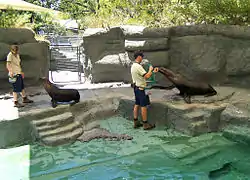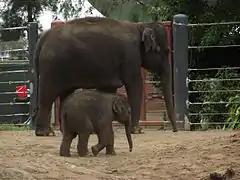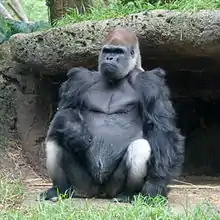Melbourne Zoo
Melbourne Zoo is a zoo in Melbourne, Australia. It is located within Royal Park in Parkville, approximately 4 kilometres (2.5 mi) north of the centre of Melbourne. It is the primary zoo serving Melbourne. The zoo contains more than 320 animal species from Australia and around the world, and is accessible via Royal Park station on the Upfield railway line, and is also accessible via tram routes 58 and 19, as well as by bicycle on the Capital City Trail. Bicycles are not allowed inside the zoo itself.
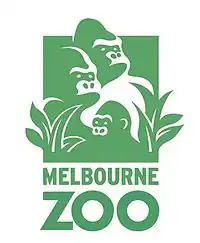 | |
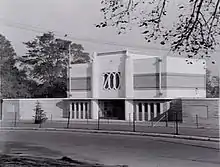 The main entrance to Melbourne Zoo | |
| Date opened | 6 October 1862[1] |
|---|---|
| Location | Parkville, Melbourne, Victoria, Australia |
| Coordinates | 37.784762°S 144.952095°E |
| Land area | 55 acres (22 ha) |
| No. of animals | 5,120 |
| No. of species | 320[2] |
| Memberships | ZAA,[3] WAZA[4] |
| Major exhibits | Elephants, lions, tigers, orang-utans, gorillas |
| Website | www |
The Royal Melbourne Zoological Gardens is a full institutional member of the Zoo and Aquarium Association (ZAA) and the World Association of Zoos and Aquariums (WAZA).
History
Melbourne Zoo is Australia's oldest zoo and was modelled on London Zoo. The zoo was opened on 6 October 1862 at the Royal Park site of 55-acre (22 ha) on land donated by the City of Melbourne. Before this, animals were housed at the botanical gardens in Melbourne.
Initially the zoo was important for the acclimatisation of domestic animals recovering from their long trip to Australia. It was only with the appointment of Albert Alexander Cochrane Le Souef in 1870 that more exotic animals were procured for public display, and the gardens and picnic areas were developed.[5]
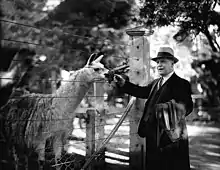
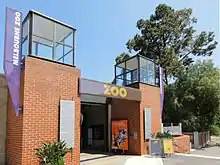
Visitors can see historical cages including the heritage listed Elephant House, which has been renovated and adapted for use for customers paying to sleep overnight in tents at the zoo in popular Roar and Snore evenings. These evenings allow the public to see some of the nocturnal animals at the zoo in evening guided tours by experienced camp hosts. One of the most famous exhibits was Queenie the elephant.
The zoo is set among flower gardens and picnic areas. Many of the animals are now organised in bioclimatic zones: African rainforest featuring gorillas, mandrills, pigmy hippos and parrots; Asian Rainforest with tigers and otters; and the Australian bush with koala, kangaroos, emu, echidnas and endangered hairy nose wombats. Popular exhibits also include the Butterfly House, the great flight aviary and the Trail of the Elephants. Melbourne Zoo most recently completed construction and opened their carnivores trail in early 2018.

The zoo includes a large schools section and caters to many school visitors annually, its immensely popular education program encourages young minds to conserve animals.
The Zoos Victoria administers the Melbourne Zoo, as well as the Werribee Open Range Zoo which features herbivorous creatures in an open range setting; and Healesville Sanctuary on 175 hectares (430 acres) of bushland exhibiting Australian fauna.
On 15 January 2010 Melbourne Zoo welcomed its first elephant calf, Mali. This is the second elephant calf born in Australia, the first being in Sydney in July 2009. Mali is the first female calf born in Australia and the first calf born via artificial insemination.
Melbourne Zoo commemorated 150 years of operation in 2012 and this was celebrated in an Australian Zoos collector's edition of stamps released by Australia Post in September 2012.
Exhibits
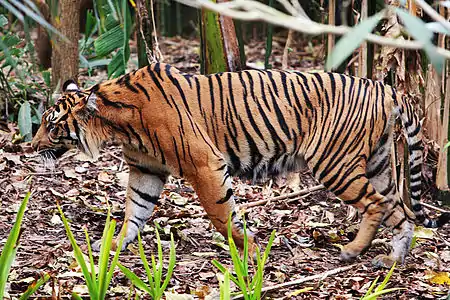
- Trails of the Elephants: six Asian elephants — females Mek Kapah (the matriarch), Dokkoon, Kulab, Num-oi, Mali (daughter of Dokkoon) and Man Jai (son of Dokkoon), the herd rotates through one of the three paddocks throughout the day. The zoo used to have Ongard (son of Kulab), who is currently in Zoo Miami and an adult bull elephant named Bong Su who is patriarch of the herd and father of all the calves; sadly, he passed away in 2017 due to long battle with arthritis since 2005. Bong Su arrived at the zoo as a gift from the Sultan of Pahang (on the Malay Peninsula) as an orphan in 1997.
- Butterfly House: a greenhouse-style walk-through exhibit for tropical butterflies.
- Orangutan Sanctuary: Home for the Zoo's two families of orangutans (one consisting of pure Sumatran orangutans and the other of Sumatran-Bornean hybrids).
- Asian rainforest: the original portion of the Asian rainforest adjoins Trail of the Elephants and Orangutan sanctuary. Includes enclosures for Sumatran tigers, Asian small-clawed otter and two small aviaries for Asian birds.
- Australian Outback: features kangaroo island kangaroos, emus, southern hairy-nosed wombats, koalas and a variety of small bird aviaries.
- Great Flight Aviary: a large free-flight aviary within the Australian outback exhibit dating from the 1930s. Visitors walk along a boardwalk through three different bioregions representing an Australian rainforest, wetlands and bushland. Significant species include southern cassowaries, brolga, royal spoonbills, eclectus parrots, and red-tailed black cockatoos.
- Lion Gorge: Home to male lions born at Werribee zoo, African wild dogs, snow leopards, coatis, sumatran tigers and Tasmanian devils.
- Wild Sea: This $20 million development houses long-nosed fur seals, little penguins, Fiordland penguins, australian pelicans and Australian fur seals. With underwater sounds and a projector screen coupled with the beautiful lighting effects it has a calming touch of realism. Little penguins and seals can be viewed from above water level and below.
- Reptile house: contains a variety of Australian and exotic reptiles.
- African rainforest: This walk opens with the walk through 'lemur island' exhibit, home to a troop of male ring-tailed lemurs. the major exhibit at the centre of this area is for western lowland gorillas.
- Treetop apes and monkeys: A series of netted enclosures viewed through glass windows from an elevated boardwalk. Species currently include white-cheeked gibbons, black-handed spider monkeys and Black-and-white colobus, Cotton-top tamarins. This walk follows on from the African rainforest.
- Baboon Lookout: Houses the zoo's troop of hamadryas baboons.
- Growing wild: Houses meerkats and aldabra giant tortoises.
- Main trail: Home to Red pandas, Siamangs, Zebras, Giraffes, Malayan tapirs, Collared peccaries, Aldabra giant tortoises and Platypuses
Notes
- "History of the Zoo". zoo.org.au. Zoos Victoria. Archived from the original on 19 August 2010. Retrieved 27 August 2010.
- "About Melbourne Zoo". zoo.org.au. Zoos Victoria. Archived from the original on 2 July 2010. Retrieved 27 August 2010.
- "Member Location Map". zooaquarium.org.au. ZAA. Retrieved 29 January 2011.
- "Zoos and Aquariums of the World". waza.org. WAZA. Retrieved 29 January 2011.
- "The Zoological Gardens". Weekly Times (594). Victoria, Australia. 22 January 1881. p. 11. Retrieved 3 March 2017 – via National Library of Australia.
External links
 Media related to Melbourne Zoo at Wikimedia Commons
Media related to Melbourne Zoo at Wikimedia Commons- Official website
- List of species at Melbourne Zoo, globalspecies.org
